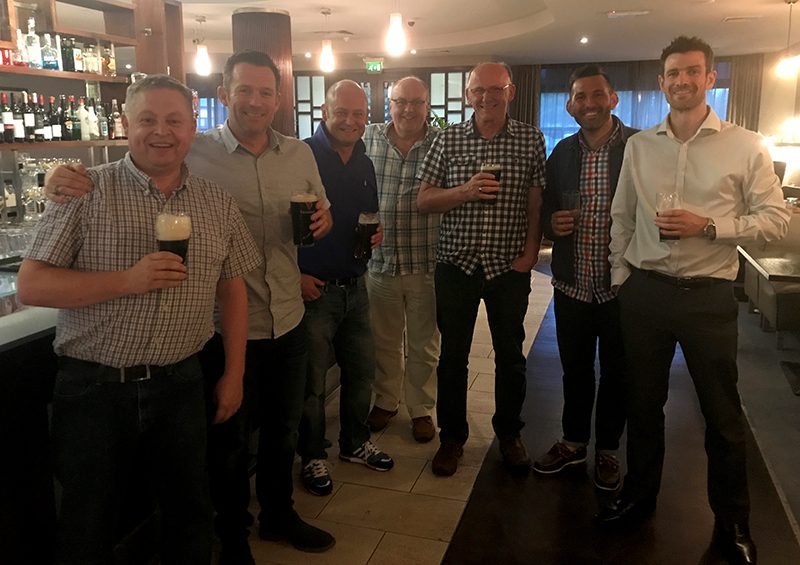In a blog about recruitment, Mr. Loadlink explains why getting shut out of his own boardroom was the highlight of 2018 so far, and suggests all business leaders should try it.

Choosing the right people to work for you is key to growing a business.
It was like the Mary Celeste (if the merchant brigantine was the premises of a load cell manufacturer). Computer screens were on; many hadn’t gone to screen saver. Desks were strewn with paperwork, Post-it notes, and other stationery. A stack of catalogues had been left on the corner of a table, as though someone expected to walk past and pick them up any minute. A cup of coffee was half-drunk but still steaming.
I was waiting for someone to jump out from behind a cupboard and yell, “Surprise!” But it wasn’t my birthday, nor do we make a habit of playing hide-and-seek in the office. I didn’t hear a fire alarm and I knew a drill wasn’t scheduled. My watch was still ticking and in sync with my mobile phone. I could hear the machine tools at work in our neighbouring building and a DHL lorry had just driven out of the yard, full of load cells. It was business as usual, yet this corner of the office was deserted, and I really wanted to ask someone a question.
As I widened my search I walked past the boardroom. The blinds were closed and the door shut. From the muffled sound of voices I could tell that the missing team members were having a meeting. So, what did I do—burst in and demand an explanation? Listen at the keyhole to check nothing untoward was being discussed? Send a text message to one of them saying, “Caught you red-handed”? How about slam the table and ask where my invitation was? Or demand an explanation as to why important business was being discussed without my knowledge or consent?
Heel click
No, I did none of those. Instead, I smiled and walked back to my office. The question could wait. Being shut out of my own boardroom by a meeting I knew nothing about actually put a bit of a spring in my step. I even thought about doing a heel click as I went around a corner, but luckily thought better of it. Truth is, this wasn’t the first time a meeting has taken place without my knowledge, but the excitement of discovering such get-togethers never wears off. It takes an efficient, mature, well-staffed business for such meetings to happen.
There was a time when I was ordering toilet rolls, changing light bulbs, sweeping the floors, boxing up shipments, selling, quoting, visiting, and more. And that was just on Monday mornings. Nobody even breathed at Straightpoint (SP) without me knowing about it or having something to do with it. It wasn’t because I was a control freak, but that’s how it is for CEOs, managing directors, and business leaders in the early days of ownership or tenure. We all remember being the boss, finance manager, operations guy, marketing team, and product designer all at the same time.
That’s fine in the beginning but as a company grows its manager must recruit wisely and start to delegate certain responsibilities to other people. Gary Mullins, of Action Coach, sums this up well: “Work on the business, not in the business,” he says. What he means is a CEO is more effective if free to represent the company, plan, strategise, and lead. Too many still wear it as a badge of honour that they hold down five different roles at their company. Nobody gives out prizes to business owners who still order ink for the photocopier or come in at the weekend to clean.

A failure to recruit and delegate can result in a business leader trying to keep too many balls in the air. Eventually they’ll drop one.
Talking cobblers

If you’re a cobbler, pick the right moment to go headhunting at Oliver Sweeney.
It’s a piecemeal process and integral to its success is effective and astute recruitment, aligned with the growth and goals of the business. Take a cobbler, for example. When it’s a startup in a garden shed, it’ll be the one man or woman band described above. He or she will be ordering leather, making the shoes, deciding how to market them, trying them on for size, and delivering to customers. As orders grow and a 50-hour week becomes a 60 then 70-hour one, a need to recruit presents itself. A good option might be to hire an apprentice to work so many hours a week around studies. They can deal with ordering, cutting, measuring, and shipping, whilst learning the trade. Breaking the bank to bring in the top person from Oliver Sweeney would be premature, however.
It’s about timing. As the cobbler grows, recruitment has got to be aligned with that expansion. Perhaps once the apprentice is fully qualified and full-time, the third person to join takes care of administration and marketing. As the premises expand or the business relocates, there’ll be a need for additional personnel. Eventually, when a fully staffed production line is generating seven-figure revenue, it might be time to go knocking on the door of the guy from Oliver Sweeney. Not only will the business be able to afford it now, but also it’ll be an altogether more enticing proposition.
Regular readers of this blog will know I’m a big advocate of planning and I’d like to think SP’s growth is testament to the value of a strong plan. Even a start-up company with one employee can have an aggressive growth strategy in place. Say, a door manufacturer has ambitions to be a £5m company; they can look at the time, costs, logistics, etc. involved with making one set of doors and upscale accordingly. Even on day one they could list the roles required and set about filling them up as revenues and profits allow.
Role-play
We did the same thing here at SP. What proves effective for us is recruiting to fill two or three roles with one person and adding personnel as workload dictated. For example, a bookkeeper might also wear the purchase order-processing hat until both roles become too demanding; then it might be time to bring someone else in to manage order-processing. A different business might have a delivery and chauffeur service. One man or woman can dress accordingly to fulfill the transportation tasks as long as they’re not needed at the same time. Once it gets to the point where a delivery needs to be made to Portsmouth and a regular client books a ride to Birmingham Airport the same morning, there’s obviously a need to get another driver.
Be mindful that recruitment plans are designed to facilitate not hamper growth. Thus, they’ve got to be flexible. We didn’t necessarily have a role on paper for Wayne Wille, who joined us in the U.S. as technical sales manager a couple of years ago. But with over 20 years of lifting industry experience to offer, it was the right business decision to bring him on board. The aforementioned cobbler might get a knock on the door from the fellow at Mr. Sweeney ahead of time, and they may deem it prudent to get him when they can. Market conditions also dictate. If it wasn’t foreseen that demand for a certain product was going to double, react accordingly; don’t regret it wasn’t in the plan and let a moneymaking opportunity slip away by not properly staffing the production line.
A good barometer by which to measure a company’s status or reputation in an industry is the frequency with which those from competitors or elsewhere in a marketplace looking to switch allegiances approach it. This isn’t a competition (I’ve blogged extensively about my belief in abundance for all companies) but it does give me a tremendous sense of satisfaction when someone from outside the business reaffirms what we think of ourselves on the inside. It’s one thing us communicating to market that our load cells are the best, but when that’s the consensus among competitors and peers, it’s clear we’re doing something right.

Does the competition knock at your door looking for a job?
DNA match
Introducing the right people to a company isn’t only based on their experience or résumé. At SP, we’re big believers in hiring professionals whose DNA fits with our culture. Phil Roch, marketing executive; Kyle Milne, technical sales engineer; Marcus MacDonald, machine shop supervisor; and Dave Mullard, business development manager (our latest UK-based heavyweight recruits), all have impressive curriculum vitae, but their attitudes, charisma, and personalities have allowed them to fit in with the existing team and buy into the over-arching SP concept.
It’s true that recruiting at a higher level will cost a business more than the apprentices and junior members of staff that a start-up might acquire. It’s not a reality to be feared, however. Don’t view more experienced personnel as ‘expensive’; look at them in terms of the overall value they’re adding to a business. Of course, if greed is evident in early exchanges or a person senses an opportunity to take advantage this will not only put off the prospective employer but it also raises an issue over the person’s moral fibre. Would you want someone like that working for you?
Sometimes an employer has to conduct a more forensic analysis into a prospective employee’s DNA. It’s not about trying to be too clever or catching people out, but we’ve found that questions like, “How would you sell a load cell?” or “What goes into designing a new force measurement product?” are pretty fruitless in terms of getting to know a person. “Why might you not still be here in two years time?” is one question that often extracts a more interesting, rounded answer.

A new recruit must have SP DNA.
Compact DISC
Action Coach introduced us to the DISC profiling system whereby candidates answer simple questions. The resulting score can be analysed and compared to existing employees. It’s doubled up as a great tool for managers as they have an idea of how someone might react under pressure or to a certain situation before they’ve even started. In sporting terms, I guess it’s about knowing who to give the hairdryer treatment to and with whom to take a softer approach. A recruiter might be encouraged or dissuaded if a score suggests the candidate is very similar or completely opposite to those he or she will report to or work alongside.
A key component of successful recruitment is keeping existing employees engaged, motivated, challenged and incentivised. We give our new starters a warm welcome and recruitment usually results in media coverage and a spotlight being shone on the individual. But that doesn’t mean they’re better than what we’ve already got or that we’re introducing new people because of the existing team’s shortcomings. Again, if the DNA match is right, a person will acknowledge the marketing function but recognise that they’re part of a team.
If a business is regularly recruiting, it’s a good idea to empower all staff, particularly those who’ve been on the books a long time, to contribute to strategy and growth. My door is always open and, only recently, Zoe Silk, sales and hire, approached me with a number of good ideas that we will be sure to implement going forward. It’s a surefire way to demotivate and disengage employees to not listen to their ideas or comments, particularly if they’re being relayed from the coalface to a CEO who has lost contact with the market. We have people working at SP who tried to communicate such issues to previous employers but were told their observations, no matter how astute, were not a fit with company policy.
Good luck with your next recruitment campaign!
Mr. Loadlink


